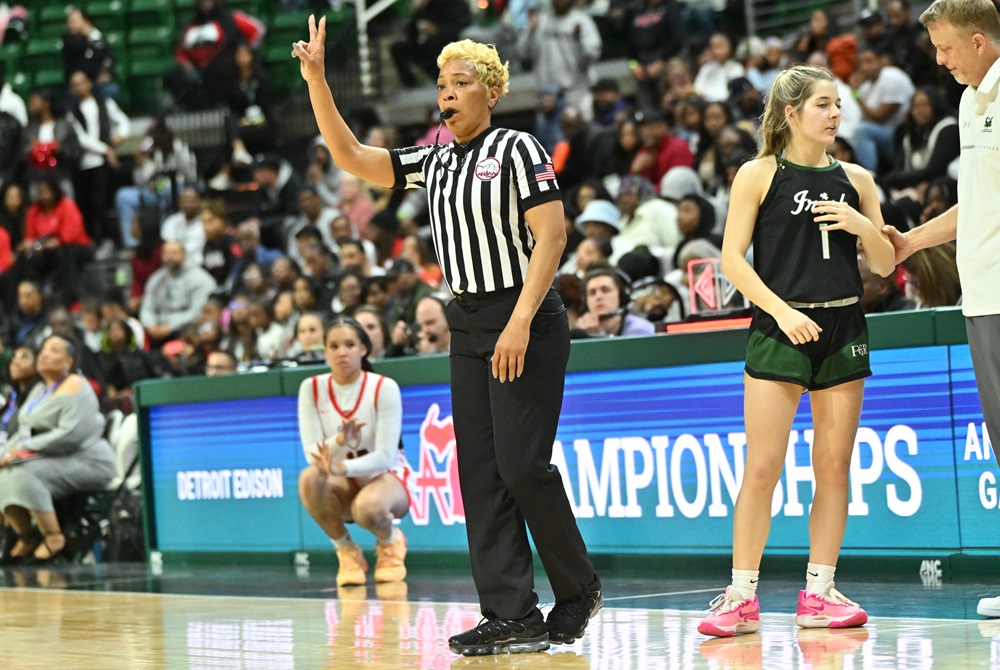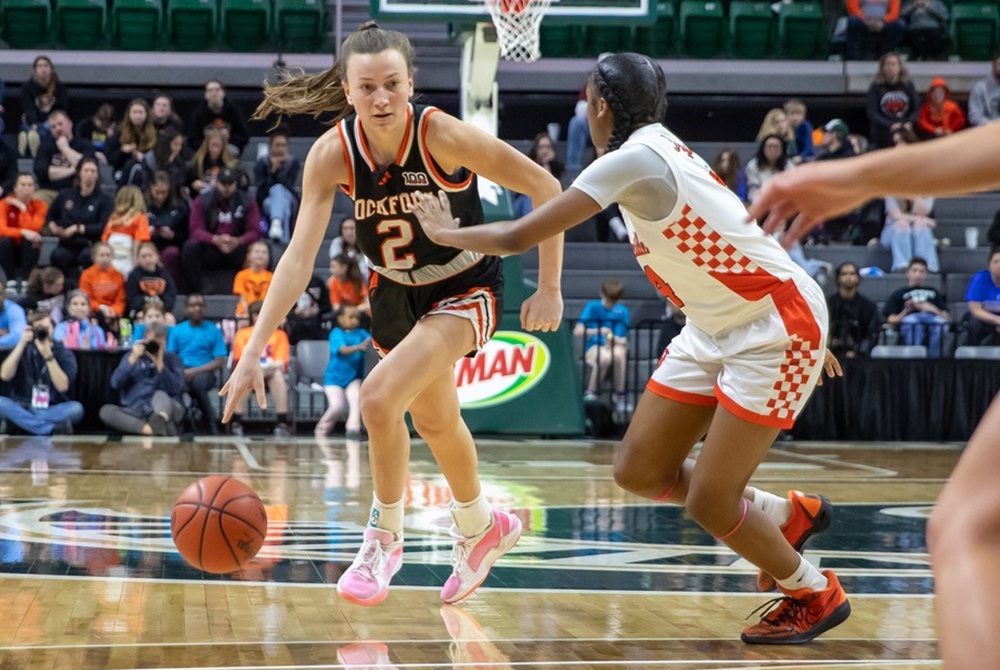
Be the Referee: Basketball Goaltending
By
Paige Winne
MHSAA Marketing & Social Media Coordinator
December 3, 2024
Be The Referee is a series of short messages designed to help educate people on the rules of different sports, to help them better understand the art of officiating, and to recruit officials.
Below is this week's segment – Basketball Goaltending - Listen
In basketball, what’s the difference between goaltending and defensive basket interference?
Goaltending is when a defensive player touches the ball when it is on its way down toward the basket, or after the ball has hit the backboard and is in a downward trajectory towards the hoop.
Defensive basket interference is when a defender touches the rim or net while the ball is within or on the cylinder. However, if the defender touches only the net and does not affect the shot in any way, then basket interference is not called.
In both instances – goaltending and basket interference – the outcome is treated like a made basket: two points to the offense unless the shot came from behind the 3-point arc, and then it’s worth three points.
Previous 2024-25 Editions
Nov. 26: 11-Player Finals Replay - Listen
Nov. 19: 8-Player vs. 11-Player Football - Listen
Nov. 12: Back Row Setter - Listen
Nov. 5: Football OT - Listen
Oct. 29: Officials Registration - Listen
Oct. 22: Volleyball Serve - Listen
Oct. 15: "You Make the Call" - Soccer Offside - Listen
Oct. 8: Roughing the Passer - Listen
Oct. 1: Abnormal Course Condition - Listen
Sept. 25: Tennis Nets - Listen
Sept. 18: Libero - Listen
Sept. 10: Cross Country Uniforms - Listen
Sept. 3: Soccer Handling - Listen
Aug. 24: Football Holding - Listen

Rockford's Miss Basketball Caps Career Among State's Top Shooters, All-Time Winners
By
Geoff Kimmerly
MHSAA.com senior editor
December 19, 2025
Rockford’s Anna Wypych finished her high school career in March with four record book listings earned during her four-year varsity career and Miss Basketball Award-winning senior season.
She made 94 3-pointers last winter, good for fifth all-time, and finished her career with 203. She also made the career games played list with 107 and career wins list helping the Rams to a 99-8 record. Rockford won the Division 1 championship in 2023, finished runner-up last winter and also made the Semifinals when Wypych was a freshman and junior.
She’s continuing her career this season at Butler.
See below for several recently-added listings to the girls basketball record book, and click the heading to see the record book in full. Several more applications have been received and are in the process of being confirmed.
Girls Basketball
Mia McGregor is up to 26 listings in the record book after her first two seasons at Mio. Her 58 points in a game against St. Helen Charlton Heston as a freshman is tied for ninth and one of her 12 games scoring 45 or more points. Her 866 points (41.2 ppg average) that debut season rank second all-time, and she’s already on the career 3-pointers (160) and free throw (345) lists. She also made the single-game assists list with 14 against Atlanta last season.
Jaxi Long’s heroics at the end of a 61-54 win over Muskegon Western Michigan Christian on Jan. 4, 2022, have her second on a record book list. She scored 29 points, including 22 in the fourth quarter, as Newaygo came back from an 11-point deficit that period. She’s playing at Cornerstone.
Baraga senior Kara Roberts made the single-season 3-pointers list as both a sophomore (74) and junior (70). Baraga as a team also made multiple 3-pointer lists over the last few seasons, including with 13 in a game last winter. Roberts has committed to continue at Wisconsin-Eau Claire.
Morrice’s Aubrey Rogers totaled 20 steals during a Feb. 2, 2024, win over Burton Bendle, tying for second-most in one game. She was a senior and has continued at Spring Arbor.
Ishpeming’s march to the Division 4 championship in 2024 includes several record-book accomplishments as a team and individually. As a team, Ishpeming tied the single-season record of 28 wins in finishing 28-1, and made lists with 195 3-pointers and 710 attempts from beyond the arc. Then-junior Jenessa Eagle made the record book with 72 of those 3-pointers. She has signed with Michigan Tech.
Evart junior Kyrah Gray made the single-season steals list with 15 in a Dec. 6, 2024, game against Beal City, and finished the season with 188 over 25 games – the season total ranking fifth all-time.
Averie Zinn has entered her senior season at Genesee with 20 record book listings – and a chance to add several more. Zinn’s best from her first three seasons included 851 points scored (32.7 per game) last winter, which rank third all-time; 186 free throws last season, which rank 10th; and 218 steals also from last season that rank third on that list. She has committed to Wayne State.
Charlotte senior Peyton Howarth cemented her name in the record book with nine 3-pointers in a Dec. 7, 2024, game against Quincy. She finished with 29 points.
Vivian Idziak earned Grand Rapids Union’s first record book entry in this sport with 15 blocked shots against Muskegon Reeths-Puffer on Jan. 16, 2024, and added a second with 27 rebounds against Wyoming Kelloggsville this past Feb. 25. She graduated this spring and will continue at Grand Rapids Community College, where she will run cross country.
Braxcynn Baker finished her Lowell career in 2024 with several record book listings, including for 183 free throws (in 223 attempts) as a senior and 479 free throws (ranking eighth) in 587 attempts with an .816 percentage for her career. She also made the career 3-pointers list with 180 over 91 games. Her senior-season free throws contributed significantly to Lowell’s MHSAA-record 319 over 25 games that season. She’s continuing her career at Murray State.
Orchard Lake St. Mary’s earned its first girls basketball record book listings during the 2023-24 season. As a team, the Eaglets made 171 3-pointers in 487 attempts – both totals making lists – and Allie Crighton made the single-season free-throw shooting list by connecting on 87 percent of her attempts. She’s a junior and has committed to Northwood.
Fallon Behrick launched a quick start on her 32-point night for Otisville-LakeVille Memorial against Mt. Morris on Jan. 23. The senior scored 21 first-quarter points to make the single-quarter scoring list.
Milan’s Emily Bladen scored 39 points on Dec. 10, 2024, against Britton Deerfield, with 27 coming on nine 3-pointers as she made that single-game list. She’s currently a junior.
Parc Liggins also earned a spot on the single-game 3-pointers list with 10 in 14 attempts for Grand Blanc against Lapeer on Jan. 24. She’s a senior this winter.
Parchment’s 61-30 win over Delton Kellogg on Jan. 28 saw the winning team tie for the sixth-most 3-pointers made in one game – 17 – while also making the single-game attempts list with 47.
Adelyn Moore finished her career at Caro in 2023 by making single-season lists with 150 steals and 336 rebounds – and also career lists with 442 steals and 1,047 rebounds over four seasons and 80 games. She played a season at University of Chicago and is now at Denison in Ohio.
Kent City added to its growing list of top 3-point performances when it connected on 16 – on only 37 attempts – in a Feb. 11 game against Howard City Tri County.
White Cloud’s Alexis Strait tied for the fourth-most 3-pointers in a game when she made 11 on the way to scoring 37 points total on Feb. 7, 2020, against Hesperia. She was a junior that season.
Tamerah Peterson capped her Sterling Heights Parkway Christian career last winter with 633 steals – good for second on the career list – over four seasons and 86 games. Her 213 steals as a sophomore rank fourth for a single season. She was joined in the records by now-junior Angelina Marchesi, who made the single-season rebounds list with 312 over 24 games. Peterson is running track at Spring Arbor.
Merrill’s Maddy Desmyter entered her senior season with a record book entry after grabbing 316 rebounds over 23 games last winter. She has committed to Adrian College.
Twice over five days in February, Analeis Ming made the single-season assists list with two of the highest-ranking performances in state history. She had 15 assists in Au Gres-Sims’ game Feb. 13 against Atlanta and 17 steals on Feb. 17 against Fairview. She is a senior and has committed to play soccer at Knox College in Illinois.
Jayna Schwartz capped her Battle Creek Calhoun Christian career last winter with 73 3-pointers over 21 games, making that single-season list. She just missed the single-season list as a junior with 64.
Madeline Pier tied for 13th all-time on the single-game rebounds list when she grabbed 30 in Swartz Creek’s win over Flint Kearsley on Jan. 31. She’s a junior.
Saline’s Keira Roehm drained 100 3-pointers last winter – third-most in MHSAA history – and had 238 entering her senior year to already rank 12th on the career list after 73 games. She contributed significantly to Saline’s team total of 174 over 24 games. She’s committed to Wayne State.
Hanna Vaughn added 46 more 3-pointers as a senior last season to finish her four-year Ironwood career with 201 over 92 games. She’s playing volleyball and basketball at Gogebic Community College.
Nearly 50 years later, the longest overtime game in MHSAA girls basketball history has been uncovered. Michigan Center defeated Grass Lake 57-50 in six overtimes on Oct. 11, 1978. Coincidentally, Michigan Center also played in a five-overtime game that was tied for the record before this result was added to the top of the list.
Niles Brandywine added to its several listings for 3-pointers attempted and made, connecting on 198 of 689 attempts over 28 games last season. Both rank among the top 15 in their respective categories.
Victoria Hauffe has entered her senior season at Hemlock already on the career 3-pointers list with 159 over her first three seasons and after connecting on 69 last winter. Hemlock as a team was added to the records for making 13 3-pointers against Essexville Garber last December and attempting 529 over 25 games.
Dena Droste played four varsity seasons for DeWitt through graduation in 2011, and finished on the career 3-pointers list with 152 in 415 attempts. She went on to play at Kent State and Ferris State.
PHOTO Rockford's Anna Wypych (2) makes a move toward the lane during last season's Division 1 championship game.

